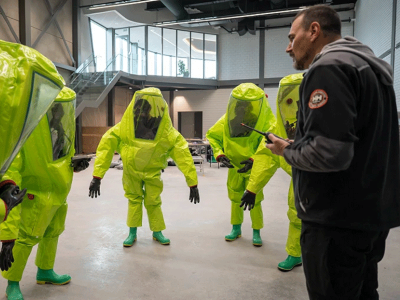This year, my colleagues at the Organisation for the Prohibition of Chemical Weapons (OPCW) — which implements the Chemical Weapons Convention, an arms-control treaty that entered into force in 1997 — and I reached a milestone: we verified that the last remaining declared stockpiles of chemical weapons in the world had been destroyed. Now, the OPCW is intensifying its focus on ensuring that these weapons do not re-emerge. This involves bolstering the political commitments and collective will needed to maintain the norm against the use of chemical weapons, as well as preventing the proliferation of materials, equipment and expertise.
As the OPCW’s science-policy adviser, I monitor the impact of advances in science and technology on the implementation of the convention and the organization’s work. I now find us facing an ongoing challenge — one that collaboration from governments and the scientific community can help us to overcome.
In 2019, the OPCW’s 193 member states decided unanimously, for the first time in history, to add compounds to the schedules, the lists of chemicals that are regulated under the convention. The four entries comprise toxic nerve agents with no known civilian use: three cover phosphorus-based agents (in the ‘novichok family’), and the fourth is a family of carbamates, another kind of nerve agent. The convention already prohibited using these (or any chemical) to intentionally kill or harm people through toxicity. Now, their production, transfer and storage are subject to stringent verification by the OPCW, through declarations and on-site inspections.

The world’s top chemical-weapons detectives just opened a brand-new lab
Yet some states have been reticent to share data on these chemicals with the OPCW. The lack of information on the newly scheduled chemicals is in jarring contrast to what we have on other weapons listed in the convention and on their precursors. To ensure the health and safety of staff members during inspections, the OPCW needs the best understanding of these chemicals’ properties, the types of personal protective equipment and medical countermeasures that are effective against them and the analytical methods for detecting them. These data would also help us to provide the best information and training to all member states, ensuring that they are prepared in the event that any of these chemicals are used as a weapon.
Sharing information also enhances national security. It builds trust by increasing confidence that other nations are abiding by mutually and voluntarily binding agreements. When member states can detect, treat and respond to the consequences of the use of chemical weapons, that itself acts as a deterrent and decreases the risk of their use.
The annual Conference of States Parties, which will take place in the Hague, the Netherlands, from 27 November to 1 December, is an excellent opportunity for everyone to agree that making scientific data available is important — a fundamentally apolitical aspect of the convention and the OPCW’s work.

Novichok nerve agents banned by chemical-weapons treaty
Hesitation to share information has been overcome in the past. For example, the Comprehensive Nuclear-Test-Ban Treaty Organisation (CTBTO) continuously monitors Earth for signs of nuclear explosions, in support of its namesake 1996 treaty, which bans all nuclear tests. It records extensive data through a broad network of seismic, hydroacoustic, infrasound and radionuclide facilities. These data were initially not shared openly.
The turning point came after the catastrophic earthquake and tsunami off the coast of Sumatra, Indonesia, in December 2004. The tsunami’s death toll reached an estimated 230,000. Signatory states began asking: could the rapid sharing of CTBTO data have helped to save lives during this disaster? Seeing the enormous potential of these data for diverse scientific endeavours, parties to the test-ban treaty overcame their initial reluctance to share sensitive data and found a way to do so without compromising national security. Now, the wider scientific community can access CTBTO data for many research and civil applications, from tracking meteors and pinpointing lost submarines to following marine-mammal migration. Expanding member states’ comfort zones has proved to be a win–win.
In the case of the newly added compounds to the Chemical Weapons Convention, information sharing could be approached in a stepwise fashion to build confidence. Initially, to ensure the fidelity of our ongoing operations, member states could provide relevant technical information on these chemicals only to the OPCW Technical Secretariat. After a period of time, when member states are comfortable with how the information is being used, the OPCW could facilitate the sharing of relevant information with all member states, strengthening their ability to prepare for and respond to any misuse of these chemicals.
The Chemical Weapons Convention is widely considered to be the world’s most successful international disarmament treaty, because it has eliminated an entire category of weapons of mass destruction. The OPCW is equally successful — recognized for its efforts in 2013 with the Nobel Peace Prize. At this landmark moment, when all global declared stockpiles of chemical weapons have been destroyed at last, let us have the tools we need to ensure ongoing success and a safer world.
